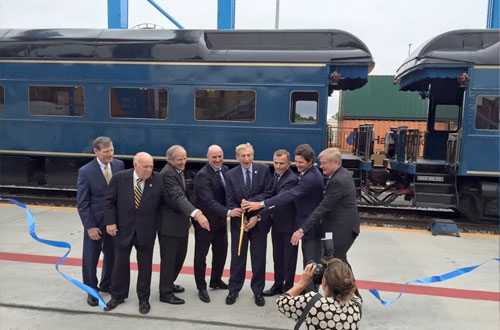Port of New Orleans dedicates Mississippi River Intermodal Terminal
Written by Jenifer Nunez, assistant editor
The Port of New Orleans Board of Commissioners joined a host of elected officials and industry partners April 12 to dedicate the port's new $25-million Mississippi River Intermodal Terminal.
“When we invest in transportation infrastructure, we’re building for our future,” said New Orleans Mayor Mitch Landrieu. “The new Mississippi River Intermodal Terminal will move marine and rail cargo more efficiently, creating new, exciting opportunities for trade and growth that will yield hundreds of new jobs. The Port of New Orleans plays a major role in our global economy and is an irreplaceable economic engine for our city and state.”
The new rail yard features four tracks with 1,550 feet of working pad for each track, in addition to a runaround track. Two new rubber-tired gantry cranes built by Konecranes are part of the project scope, further increasing cargo handling and efficiency. A new marshaling yard of 18-inch concrete paving will provide an additional 64,000 twenty-foot-equivalent units (TEUs) of capacity in the Napoleon Avenue Container Terminal. In addition, the new terminal design will make five more acres available for the planned expansion of the Napoleon Avenue Container Terminal.
“This new terminal provides a highly-efficient option for our customers moving cargo via rail,” said Gary LaGrange, port president and chief executive officer.
The terminal, made possible by a $16.7-million Transportation Investment Generating Economic Recovery (TIGER) grant, has a capacity of moving 160,000 TEUs per year by rail.
The TIGER grant provided about 68 percent of the total funding for the terminal. The port’s capital budget covered the remaining investment, which provided 280 temporary construction jobs and will create an estimated 100 new permanent maritime jobs.
“New Orleans is a major player for national and international cargo operations and now, we have the assets and capabilities needed to remain competitive at the highest level in the global market,” said David Schulingkamp, Chairman of the Board of the New Orleans Public Belt Railroad, the shortline railroad that provides the port’s connectivity to its six Class 1 railroad partners. “This new railyard will improve shipping logistics tremendously, which will in turn grow cargo business for the Port of New Orleans.”
The Port of New Orleans is a deep-draft multipurpose port at Louisiana’s Lower Mississippi River. Connected to major inland markets and Canada via 14,500 miles of waterways, six Class 1 railroads and the interstate highway system.
To stay ahead of market demand, the port has invested more than $100 million in capital-improvement projects since 2012 and has a Master Plan to expand the Napoleon Avenue Container Terminal to an annual capacity of 1.5 million TEUs.





